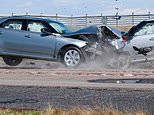Toll of drink-driver victims reaches more than 2,000 who were killed or seriously injured in 2019
Number of drink-driver victims reaches eight-year high: More than 2,000 people were killed or seriously injured by drunk motorists in 2019, new figures show
Drink-drive victims killed or seriously injured is at its highest for eight yearsAround 2,050 people were victims of serious drink-drive accidents in 2019The estimate for number of fatalities was 230 – 13% of fatalities in road accidents
The number of drink-drive victims killed or seriously injured is at its highest for eight years.
Around 2,050 people were victims of serious drink-drive accidents in 2019, the latest year for which statistics are available.
It was an 8 per cent increase on the year before and the highest since 2011.
Of these accidents, the estimate for the number of fatalities was 230. It means drink-drive related deaths accounted for about 13 per cent of all fatalities in reported road accidents in 2019.
The figures came as the number of motorists breathalysed by police officers in England and Wales fell to a record low in the same year.
Drink-drive victims killed or seriously injured is at its highest for eight years – around 2,050 people were victims in 2019, with 230 of these proving fatal (stock image)
According to Home Office data of 40 police forces, just 302,281 breath tests were carried out – an 11 per cent fall compared with the previous year. The 2019 figure is also the lowest since records began in 2002, and 57 per cent fewer than the 2009 peak of 698,688.
When all drink-drive incidents were considered, including minor casualties, there were around 7,800 accidents – the lowest level on record. This was a fall of 10 per cent from 8,680 in 2018.
It means around 5 per cent of all casualties in reported road accidents in 2019 involved drink-drivers. The highest casualty rate was in Wales at 6.9 per cent, followed by England at 5.1 per cent and Scotland at 4.6 per cent.
Within the English regions, the rates varied from the highest of 7 per cent in the East Midlands to the lowest in Greater London with 2.9 per cent.
The figures, released by the Department for Transport yesterday, also showed nearly 80 per cent of accidents involved male motorists. The majority of drink-drive casualties, 64 per cent, also involved people aged between 25 and 29.
The figures came as the number of motorists breathalysed by police officers in England and Wales fell to a record low in the same year (file image)
Nicholas Lyes, of motoring organisation the RAC, said the figures were a ‘chilling reminder’ the number killed by drink-drivers had ‘barely fallen since 2010’.
He added that ‘more needs to be done’ to tackle the issue, calling for progress on cutting re-offending such as through the use of alcohol interlocks – where drivers blow into a breath-testing device connected to the vehicle’s ignition system to start the car.
A report by the parliamentary advisory council for transport safety published in May stated that one in six drink-drive offences since 2010 were committed by a driver previously convicted for drink or drug-driving.
A Department for Transport spokesman said it had begun a three-year review into roads policing and enforcement, adding: ‘Drink-driving is illegal, and there are tough penalties in place to reflect the fact that those who choose to do it not only put their own life at risk but also the lives of others.’
![]()


